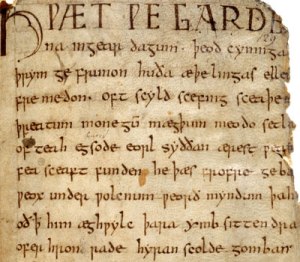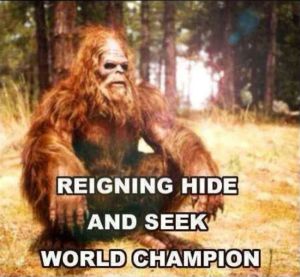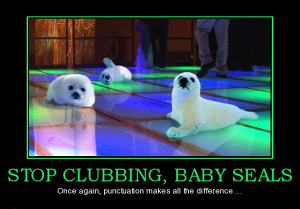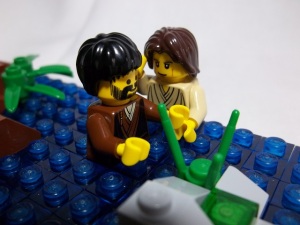My Entire Editing Process In One Checklist
August 25, 2015
Editing can be overwhelming. There are plot holes, undeveloped characters, stilted lines of dialog, grammar slips, and a host of so many other annoying things to worry about that it’s easy to stare at a draft and say, “Where do I even begin?”
I faced the same problem until one of my professors suggested integrating checklists into the editing process. Why had I never thought of that before?! No more juggling fifty knives at once! No more awkward workshop moments where I say, “Oh, yeah, I forgot to change that.” And more importantly, no more fear over whether I’ve done everything I could for a manuscript.
I’m a believer in the power of lists. While every writer has a different process, I thought I would share what I do in the hope that I might inspire someone. My editing checklist is constantly evolving, but here’s what it looks like right now (I must warn you, it’s ugly; I couldn’t fix the spacing in the transition from Word, so I had to get creative):
I. Let the manuscript cool
II. Read through the entire piece without touching it
III. Structure
A. Theme
1. What is this piece about?
2. What’s at stake? Why does this piece desire the reader?
3. Does everything tie together at the end?
B. Plot
1. Map the plot; consider five major plot points as road signs
a. Setup
i. Are all main characters present?
ii. Make sure you introduce the problem
b. Conflict
i. Inciting incident
ii. Character arc
iii. What’s at stake?
c. Resolution
i. Problem boils over into climax
ii. Denouement
2. Map subplots
3. Patch holes
4. Remove excess
C. Character
1. Highlight character names
a. Does a character disappear anywhere? Is he/she supposed to?
2. Catalog traits and background information
a. What are the characters’ motivations?
b. If you are a character (such as in memoir), make sure to catalog yourself
c. Sprinkle information throughout the manuscript
D. Imagery and Setting
1. Consider the mood of the scene
2. Consider details unique to time and location
3. Put the reader in the moment
a. Sight
b. Sound
c. Touch
d. Smell
e. Taste
f. Movement
4. Play “hide and seek” to unpack more details; repeat step 3 as appropriate
E. Dialogue
1. Does it sound real? Does it flow naturally?
2. Do the characters sound different from each other?
3. Do any lines make you cringe? If so, are they supposed to?
IV. Sentence level
A. Order sentences within the paragraph; order paragraphs within the page
B. Check point of view and tense
C. Check passive voice
D. Check filter words (saw, heard, seemed, etc.)
E. Where is the action in the sentence? Make sure it’s in a verb and not a noun
1. Replace “to be” verbs and adverbs with active verbs wherever appropriate
F. Evaluate necessity of adjectives
1. Check noun-adjective pairings for redundancy
G. Formatting (spacing, ellipses, italics, etc.)
H. Read out loud for sound and rhythm. Repeat steps A through H as necessary
V. Let the manuscript cool
VI. Read through the entire piece without touching it
VII. Repeat steps III through VII as necessary
I’ll devote an entire draft to a single list item, such as plot and theme, while I may tackle other items, like imagery, in the same draft as, say, dialogue. Note that I’ve left sentence-level editing until the end. When I’m reviewing early drafts of my own work or someone else’s, I have to fight the urge to critique things like grammar and sentence structure. I wouldn’t paint my kitchen wall if I was demolishing it to remodel. The same principle applies to editing: I don’t want to put the effort into polishing individual lines–my own or my critique partners’–when those lines may not even make it into the next draft. But after I’ve got those nice new cabinets, granite counter tops, and the shiny kitchen sink, a little bit of spot cleaning will make the project sparkle.
With some exceptions, step VI is when I’ll finally show a piece to my writing groups, since it’s the point where I’ve done about as much as I can on my own. By waiting until I’m through the list, I can get the most out of my critique partners’ advice without wasting their feedback on things I could have corrected myself. In a way, everyone wins!
This list might look long and complicated, but without it, I believe the editing process takes a lot longer. Of course, since every manuscript is different, I may follow some things on the list differently every time I go through it. But the idea is just to have something that keeps track of where I am so I don’t have to worry about anything falling through the cracks. With that kind of peace of mind, I can focus on the art of my craft rather than get distracted by the moving parts.
Hide and Seek On Paper
August 21, 2015
The more I write, the more I come to know the truth of the old aphorism that writing is rewriting. With every new work, I’m learning to be at greater peace with my rough drafts and just let them splatter onto the page, because most of the real fun for me comes in the progressive stages of revision.
Lately I’ve been putting one of my favorite revision techniques to a lot of use: unpacking details. As I read my draft I ask myself, What’s hiding in this paragraph? This line? This word? I’ve surprised myself with what I’ve been able to pull out. Here are some examples from my current project, a literary nonfiction piece about Scout camp.
First, the rough version:
Most of the guys are at the bottom of the hill, where Kidney Lake, swollen with spring runoff, has flooded out the white-sand beach for which we camped here in the first place.
And the revision:
Most of the Boy Scouts are at the shore of Kidney Lake, lashing together a crude raft because this year’s spring runoff has flooded out the beach where we had planned to play testosterone-charged Frisbee.
While reading the rough version of this sentence, I found Boy Scouts hiding in the word guys. I also discovered some space in the bottom of the hill to include more concrete imagery and give the reader a better idea of just what those Boy Scouts are doing.
The next example transforms one paragraph into two:
I return to my chair by the fire and lose track of time. When James calls everyone back to the lake, Matthew is standing bare-chested and ankle-deep in the water with the kind of solemn expression reserved for ceremonial rites of passage.
I return to my chair by the fire and become immersed in the twisted shapes that pulse throughout the smoldering wood. A lone ant emerges from a smoking hole and skitters purposefully to the tip of the log. Perched on the edge of its ruined world, the ant appears to think deeply about the ashen pit below. I lean in; the heat blasts against my forehead as if I’m checking a cake in the oven. But it’s worse for the ant. In the chaos of the blaze, the gregarious insect has no line to fall into. A fuse blows inside that tiny brain, and the ant begins to zigzag toward the opposite end of the log—the one already engulfed in flame.
When James finally calls I realize I’m on my knees, nearly in the fire pit myself. The ant is dead. I brush off my pants and fall into line with the other Scouts. We congregate on the shore of Kidney Lake, where Matthew stands ankle-deep in the water, an alpine breeze brushing his farmer tan with goosebumps.
The length of the revision is the first thing a reader might notice; there was a lot hiding in that first sentence. Now the time between sitting down and going to the lake passes in a more engaging manner; the illusion of losing track of time is more real. The narrator is also more present as a character with stronger sensory details. There’s another single-word package, too, turning bare-chested into an alpine breeze brushing his farmer tan with goosebumps–again, stronger sensory detail.
Neither of these examples have reached their final stage yet. In the next round of editing, I may shorten them; the goal is the strongest possible language in the fewest possible words. But at the very least, this revision has accomplished a lot, turning generic details into concrete images.
Playing hide and seek with a draft is a fun way to go about revising. What other fun approaches do you take to your editing process? Share them in the comments!
To the grammar Nazis: be nice
June 9, 2015
As I browsed my Facebook feed this morning I came across an article that could have generated some positive discussion. Unfortunately, however, the person who posted the article made a minor grammatical error. While some of the comments expanded on the ideas in the article, most only pointed out the poster’s flaw then left. And boy, am I glad the grammarians put that guy in his place!
A common question I hear when people find out I majored in English is whether I’m a “grammar Nazi.” Maybe I just don’t know very many other English majors, or all my classmates and teachers in college were extraordinarily well-behaved, but the majority of so-called grammar Nazis I’ve encountered studied other subjects–often the STEM fields, in which everything follows a set of rules, and where problems usually have clear solutions. No, pursuing a field in the humanities has actually prevented my transformation into a grammar Nazi. It has shown me the changeable, boundless, even human nature of language, and the hearts of the people who use it.
My rant today is for those who do identify as grammar Nazis. If you’re so concerned with another person’s grammar that you have to correct it, I ask you: why? Do you like showing the world how intelligent you are? Or have you taken up a personal crusade to preserve the purity of the English language?
Consider this example:
Person 1, sweating and clutching his chest: “I don’t feel so good.”
Person 2, obviously the more intelligent of the pair: “I don’t feel so well.”
Person 2 shows no concern for the welfare of his friend. He doesn’t say, “What’s going on?” or “Let’s go see a doctor.” But he does succeed in teaching his friend an important lesson on usage, so gold star.
Luckily I’ve never met anyone who would treat somebody that way during a medical emergency, but we see something similar happen all the time in conversation–especially online. How many times have you seen someone take the time to craft a meaningful thought on Facebook, only to be met by a comment that reads something like this:
*you’re
or this:
grammar/sp check.
Maybe I missed a memo somewhere, but I didn’t know that a grammatical error could deprive someone of his or her voice. That’s what we do when we shine a spotlight on a person’s grammar: we give deaf ears to whatever the person is actually saying. We don’t listen. We don’t care. I believe disregarding someone’s words is one of the most inconsiderate things you could do to a person.
If you use another person’s imperfect grammar to demonstrate your own intelligence, what are you really trying to accomplish? Do you care more about that person’s thoughts and feelings, or the admiration you’ll receive for being oh, so smart? I haven’t taken a formal poll, or anything, but I’m willing to bet most people value kindness over intelligence. As Theodore Roosevelt put it, “Nobody cares how much you know, until they know how much you care.”
Don’t get me wrong: I appreciate clean, professional language as much as anyone does. Accurate spelling can mean the difference between a full bowl and a full bowel. And sometimes, punctuation can change the entire meaning of a sentence. But is a little kindness too much to ask?
But maybe you’re not doing it to prove how smart you are. Maybe you really do just love the English language and want to keep it pure. If that’s the case, though, you’re out of luck anyway, thanks to a little thing called the Norman Conquest: an event in which foreign invaders seized control of 11th-Century England and Frenchified everything. That’s right–your Facebook friends aren’t defiling your beloved English; the French beat them to it a thousand years ago! And do you know what our language looked like before that? Grab your Google Translate and give this a read:
Hwæt! We Gardena in geardagum, þeodcyninga, þrym gefrunon, hu ða æþelingas ellen fremedon.

Beowulf: the reason I laugh inside whenever I hear the words “Shakespeare” and “Old English” in the same sentence
image credit: cohort.utk.edu
That’s pure English, my friends. I’d say the French did us a favor. And our language hasn’t stopped changing. In addition to the mingling of languages that comes as a natural result of global colonization, the codification of English in dictionaries and grammar readers is only a recent occurrence on the historical timetable. If you’re so bent on everyone using “proper” English, then, who is your standard? The Queen? Noah Webster? Strunk and White? Their ideas can work in certain times and places, but they’re only opinions: different ways to navigate the muddy terrain of a language in constant motion. And with the dictionary definitions of words like literally being constantly updated in this age of rapid global communication, who’s to say the grammar “facts” you profess so freely won’t change in the coming years?
It all comes down to this: putting language in a box is about as effective as nailing Jell-O to a tree. Do you want to be the fool with the hammer?
*deep breath*
Well, I think I’ve got that rant out of my system. I just want us all to play nice–to listen to and care about each other without making it a game of “I’m smarter than you.” For everything it’s been through, our language has some wonderful words that can really make a difference to someone: “I hear you”; “I understand”; “I appreciate your point of view”; “Thank you for sharing”; the list goes on. They’re certainly more worthwhile than nit-picky comments on apostrophes and word choice.
Here I stand, naked on a street corner
June 6, 2015
I originally created this website in 2008 as a sort of portfolio for my creative projects. The Lego and photography sections were here back then, but there were also a few videos and writing samples, a page of links, an awkward third-person “about the artist” page, and a clunky welcome page that assumed visitors didn’t know how to navigate a simple menu. One college education and publicity spike later, I’m here again trimming the fat.
I don’t know for certain what this site will be yet. In addition to my coming efforts to create new pages and tweak old posts, I’ve learned that creative works are very organic things and should be allowed to become what they drive themselves to be. But I think that, for now at least, I will focus on a theme surrounding the writer’s life and creative process. Mine, specifically.
Every successful writer has a web presence–even Chaucer. But when it comes down to putting myself out into cyberspace as a writer, I find the whole thing rather intimidating. It doesn’t matter that I have a degree in English from a fine institution; writing, in its every aspect, is terrifying. My words may not be me–I hope critique of my writing will never be a critique of my character–but I expose myself a little with every line, every paragraph, every page I produce. And blogging, in which I essentially publish a rough draft, feels a lot to me like standing naked on a street corner. I can always edit after I post, but what’s been seen can’t be unseen.
Yet here I am.
I can’t tell you now what to expect from this blog. This site started out experimental in nature; whatever I do to it, that nature will remain. I expect things like post frequency and subject matter to fall into place with time. What we have here is a living, changing creation. Together, we’ll see where it goes.








